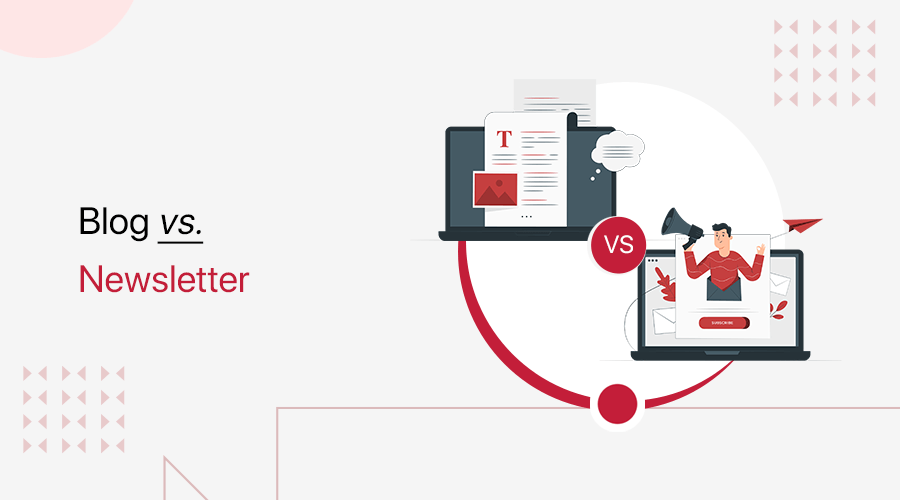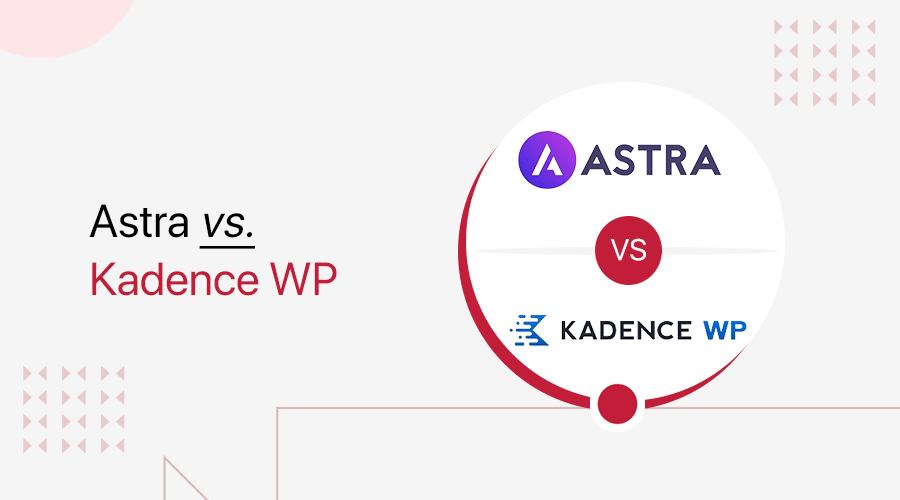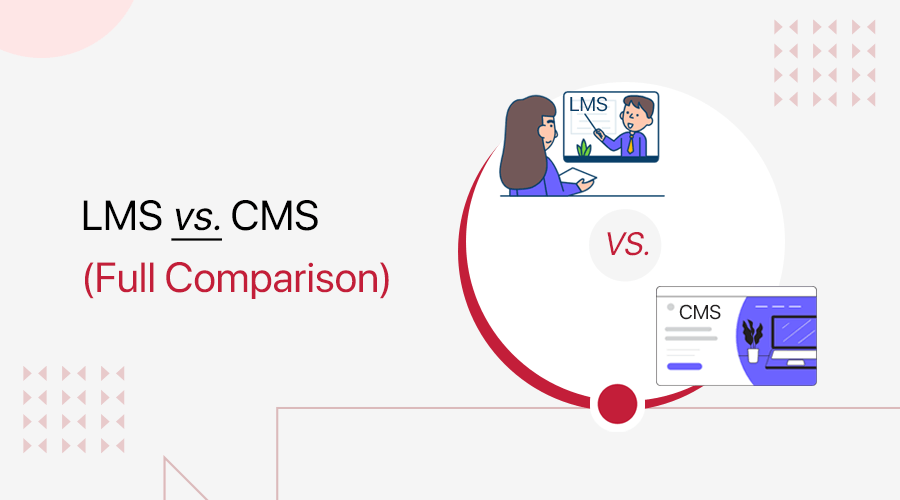
Are you looking for the differences between LMS vs CMS? Or want to know whether you need a CMS or LMS platform? If yes, then don’t go anywhere.
Both LMS (Learning Management System) and CMS (Content Management System) are online platforms for creating sites. A CMS platform has more general features for storing, organizing, and presenting data for any kind of site. While an LMS platform focuses on making eLearning sites.
But that’s not only it! You need to learn all their differences to select a suitable platform for your website needs. For that, we’ve come up with this comparison article on LMS vs CMS platforms.
So, let’s get ahead and know their differences!
A. What is LMS (Learning Management System)?
LMS stands for Learning Management System, which is a web technology or software application. It lets you plan, release, access, and store all of your eLearning courses and training materials.

Moreover, it’s an all-in-one solution to organize your learning process and reduce the time for making courses. Further, it helps your courses to reach a wider audience.
Generally, LMS platforms are used by companies to offer training to their employees. However, you can use such a platform to create online course sites. No matter if you work as an individual teacher or in formal academic or training institutes.
On top of that, it comes with many options to present your content in different formats. Like text, PDFs, videos, PowerPoints, etc. As a result, you can give interactive learning experiences to your learners.
Not to mention, you get to track the progress of your students. And also allows you to give scores on their assessments to prepare reports. All of that is from one central location. Amazing, isn’t it?
For example, Coursera.org is a popular LMS website providing flexible job-relevant online courses for individuals and organizations. Plus, get inspiration from such eLearning websites by going through our blog on the most popular online course websites.

B. What is CMS (Content Management System)?
On the other hand, CMS (Content Management System) is a simple software that lets you create, publish, and manage your site content. That too, without the need to write any code from scratch.

Moreover, it comes with a variety of tools and functions for making content for any kind of site. It means you can also build an online course website using a CMS platform.
Further, it’s composed of tools ideal for a dynamic (changeable) website. This means you can edit, delete, and update the website depending on the needs of your different users.
In addition, you can work with multiple users at the same time on your websites. And it’s possible to set permissions for your users to edit, add, and view your content.
Thus, CMS platforms help to manage the different versions of a document from a single place. It means a CMS platform can handle all the infrastructure for building web pages, storing images, and writing blogs. Also, it gives you other functions like document management.
For example, WordPress is a popular beginner-friendly CMS platform used by over 43% of sites on the Internet. It lets you build websites without the need for any technical experience.
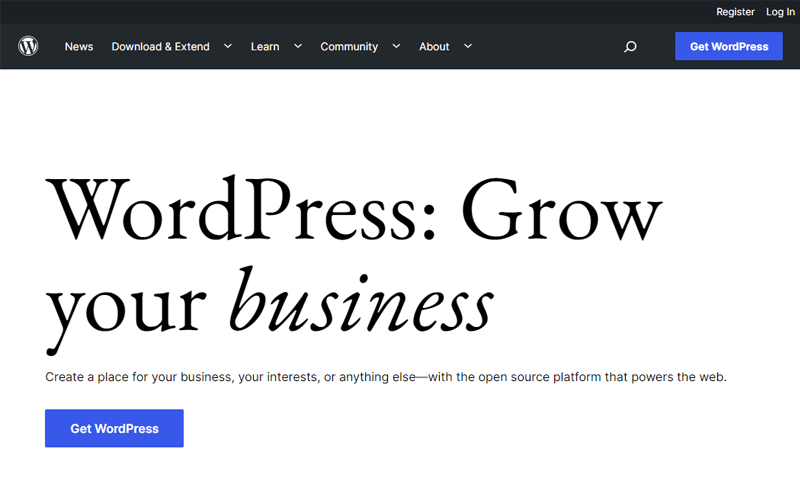
With that, let’s move into the next section of LMS vs CMS.
C. Examples of Popular LMS Platforms
Check out the table below to know examples of the best LMS platforms available.
| Popular LMS Platforms | Description | Features | Pricing |
| LearnDash | A powerful LMS platform for WordPress websites with exclusive premium features. Read our LearnDash review. | – Drag-and-drop course builder. – Advanced quizzinProgress reportsgress. | – Premium software. – Costs $29/mo on the LearnDash cloud. – As a WordPress plugin, it starts at $199/year. |
| Tutor LMS | It lets you create, manage, and sell courses on WordPress with free and premium features. Read our Tutor LMS review here. | – Personalized dashboards. – Engaging assignments. – Mobile learning. | – Contains a free plan and 3 paid plans. – The starter plan ‘Individuals’ costs $149/year or $399 for a one-time payment. |
| LifterLMS | A flexible WordPress LMS to create highly customizable courses or membership sites. Read the LifterLMS review. | – Downloadable courses. – Multimedia lessons. – Private coaching and messaging. | – Comes with a free plan and 3 paid options. – The starter plan ‘Earth Bundle’ costs $149/year. – Know the LifterLMS plans here. |
| LearnPress | An easy-to-use and comprehensive WordPress LMS application to connect your students. Check the LearnPress review. | – Multilingual sites. – Certificates for course completion. – Includes a mobile app. | – Consists of a free plan and a premium add-ons bundle that costs $600. – Able to purchase individual bundles that cost about $19 at least. |
| TalentLMS | A cloud LMS software to create and deliver training programs for your learners in any possible language. | – Gamification features. – Advanced reporting function. – Rich communication tools. | – Contains a free plan and 4 paid options and a custom plan. – The Starter plan costs $69/mo. |
| Docebo | An AI-based learning suite for creating, managing, delivering, and measuring your course materials. | – Social learning. – Mobile learning. – Integration of various tools. | Premium software that doesn’t state the price options. So, talk with the expert by filling out your contact information. |
| Absorb LMS | An award-winning cloud-based LMS platform that lets you deliver and sell consistent, on-brand training. | – Works at any location. – Supports any device use. – SCORM compliant. | A paid platform with a price that depends on your needs. So, you must first fill out the information about your LMS. |
D. Examples of Popular CMS Platforms
Look at the table below to learn the examples of the best CMS platforms available.
| Popular CMS Platforms | Description | Features | Pricing |
| WordPress | A widely-used CMS platform for creating any kind of website. It comprises tons of plugins to add eye-catching features. Learn what WordPress is here. | – Lots of themes and templates. – Easy-to-use dashboard. – User roles and permissions. | – WordPress.org is free self-hosting software. – WordPress.com is a hosted platform with free and paid plans. |
| Drupal | An open-source platform that comes with robust content management tools and APIs for multichannel publishing. | – Suits any small to big industry. – User access control options. – Theme options. | A self-hosted platform that’s available for free. |
| Ghost | It offers modern tools for creators to easily build a website and publish their content. Learn the differences between WordPress and Ghost from here. | – Send newsletters. – Offer subscriptions. – Built-in engagement analytics. | – A premium platform with a 14-days free trial. – The Starter plan costs $9/mo for up to 500 members. |
| Joomla | An award-winning CMS software to make websites and applications using unlimited designs. | – Multi-user permission levels. – Performs SEO (Search Engine Optimization) practices. – Creates multilingual sites. | A free platform with lots of free and premium extensions to add more features to your websites. |
| Magento | Rather an eCommerce platform for creating flexible and responsive online stores. So, it comprises several eCommerce features. | – Supports payment gateways. – Reliable inventory management. – Drag-and-drop page builder. | – Offers a free version. – Commerce Pro is the pro version that you need to contact its team for plans. |
E. Differences Between LMS vs CMS
Now, we’ll compare LMS vs CMS based on their different and similar features. That’ll help you know the benefits of both platforms and choose a suitable type of platform for your website.
So, let’s begin!
Benefits/Features of LMS Platforms
First, here are the main benefits or features that most LMS platforms offer. For your ease, we’ll give examples of popular LMS platforms to state our case.
1. Course and Learners Management
Each LMS platform has its own set of features for your courses and learners. Some functions are:
- Easily create, upload, and manage courses.
- Allows you to categorize and filter courses.
- Includes pre-designed templates for easily and quickly creating new courses.
- Change the layouts to match your learning process.
- Ability to enroll learners in courses.
- Lets you monitor and track the course progress of learners.
- Configure the course settings, etc.
Moreover, an LMS platform lets you perform all of these course functions from a central location. While a good LMS can also make some of these features run automatically.
Overall, LMS platforms contain tools for managing your training or courses. You can create new materials, copy and reuse classes and content, customize the materials, and manage participants.
For example, LearnDash is a popular LMS that lets you manage your courses and learners. Some management features are:
- Ability to group and sub-group users for easy management.
- Gives reports on enrollment, progress, and performance.
- Contains a drag-and-drop course builder to easily add new courses, lessons, and topics.
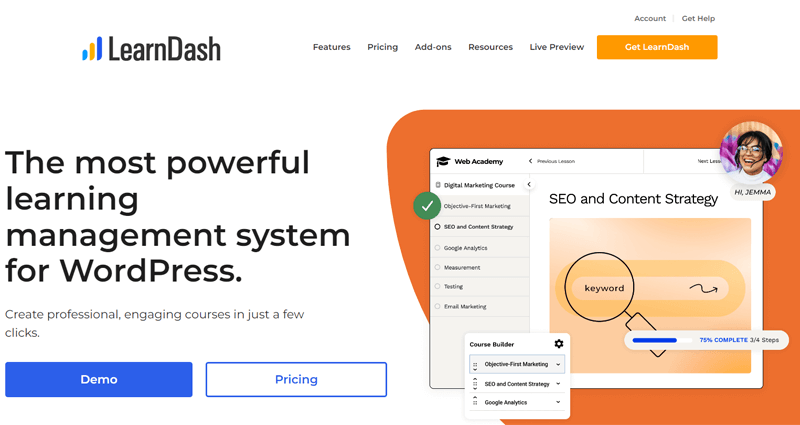
2. Integrations to Tools and Services
An eLearning site requires many functionalities to boost its business online in such tough competition. For that, you must use the best tools and services to extend your online course site.
Moreover, most LMS platforms support lots of tools and services for extending your website. Some important integrations you need to look for are:
- Web analytics like Google Analytics monitors the data measures your business success.
- Customer Relationship Management (CRM) platforms like HubSpot and Salesforce for better customer relationships and higher sales.
- Social learning tools for better interaction and participation among learners.
- Video conferencing tools like Adobe Connect, OnSync, etc. for virtual classrooms.
- Others include payment processors, compliance software, and many more.
Let’s take the example of Docebo. This LMS integrates with a variety of tools and services. Such as Google Drive, Asana, Salesforce, Shopify, Zendesk, and more.
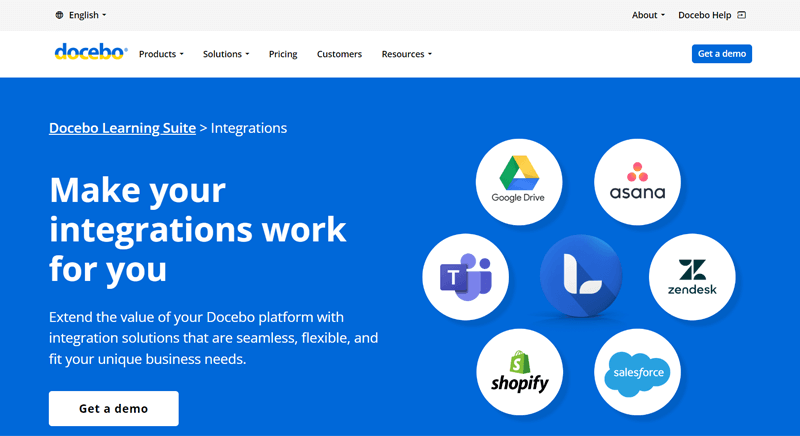
3. Course Completion Certificates
Certificates help a lot when applying for jobs. So, every LMS should allow users to get a certificate once they complete a course. And many LMS platforms do offer monitoring certification features.
Moreover, an eLearning certificate normally contains the issue date, expiration date, instructor’s name or company’s name, and the learner’s name. Further, it’s best if your LMS platform lets you customize your certificate to match your brand.
In the case of LearnPress, you’ll find a Certificates add-on. This gives a drag-and-drop certificate builder to help you make certificates for your courses. In addition, it lets you select a certificate for each course. As a result, learners will get certificates after completing their respective courses.
4. Intuitive Interface for Both Learners and Admin
An online course website is the best means for students to easily learn online. Also, the main purpose of all businesses is to offer simplified training. So, it’s a need for LMS to have an intuitive interface for learners as well as admin users.
A few features that you can find on LMSs that show how user-friendly its interface can be are:
- Learners can automatically continue their unfinished courses the next time they start.
- Customization options for sections like FAQs, the help section, etc. to guide learners.
- General overview of your training courses on dashboards.
Consequently, let’s take the example of LifterLMS. This list shows its features that prove its easy interface:
- In the Student dashboard, learners can track their activity and easily organize their actions.
- Admins can easily import and export courses for migration, take backups, etc.
- Guide you to organize and structure the design of your engaging courses.
- Able to enroll existing students in new courses with one click.
- Gives multimedia lessons using video, audio, text, or image.
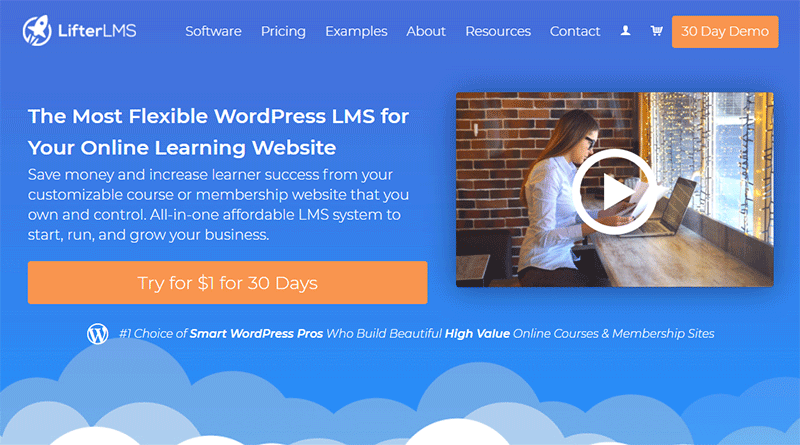
Overall, LMS platforms come with intuitive interfaces for admin and learners. In this way, creating and learning from LMS websites becomes easy.
Similarly, Absorb LMS is SCORM (Sharable Content Object Reference Model) compliant which helps in reading, understanding, and interacting with online courses.
5. Engaging Gamification and Assessments
If online courses include gaming principles, then it increases user engagement resulting in better performance. Some of the ways courses can be gamified are:
- Points
- Badges
- Leaderboards
- Social learning
- Contests
- Rewards
Thus, gamification is a must-have LMS feature that generates healthy competition and user experience.
Other than that, assessment tools also engage learners. Some assessments that LMSs offer are:
- Quizzes and exams test the knowledge and effort of the learners.
- Surveys show insights into the student’s learning experiences.
- Discussion boards for improving collaboration and communication among users.

For instance, TalentLMS lets you add multiple ways to gamify your courses from the start. That includes badges, points, levels, leaderboards, and rewards. Plus, it also allows you to build your quizzes, tests, assignments, and surveys to evaluate your learning material and your learners.
Benefits/Features of CMS Platforms
Next, let’s get into the major benefits or features of CMS platforms. Here, we’ve also come up with the best examples of CMS platforms to help you understand.
1. Built-in SEO Features
CMS platforms focus on optimizing the content and how it can reach more viewers. For that, most CMSs come with integrated functions or tools for SEO. This increases the chances of ranking your content higher on search results.
Some built-in SEO functions you can find on CMS platforms are:
- Responsive design
- Customizable URLs
- Meta titles
- Meta descriptions
- Image alt-text.

While many open-source systems contain SEO plugins or add-ons for further advanced SEO abilities. WordPress is the best example to clear things out.
This popular CMS platform includes built-in SEO features like adding titles, headings, URL slugs, post categories, and much more. On top of that, there are hundreds of WordPress SEO plugins that lets you easily configure SEO for your content.
Some notable SEO plugins are Yoast SEO, Rank Math, All in One SEO, SEOPress, etc.
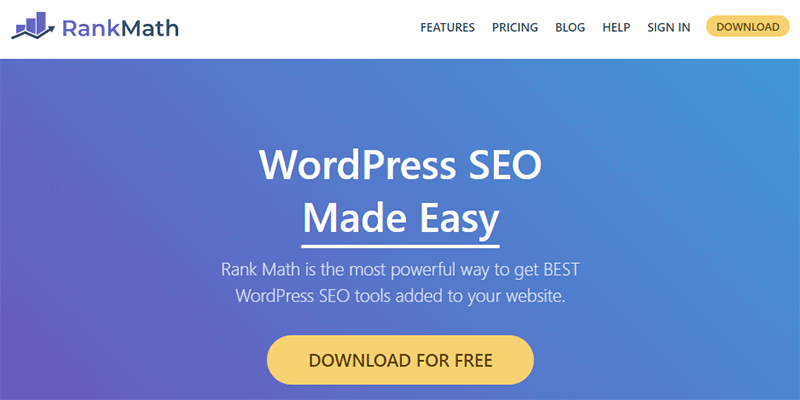
2. Easy User Management
There can be many different people using your CMS regularly to perform their set of tasks. For that, CMSs include a dedicated and reliable user management system.
This means you’ll get to assign roles to various users and give the necessary permissions to access what they can. When you control who can access which content and features, it prevents you from making mistakes.
Furthermore, you must select a CMS with customizable user administration that lets you make changes depending on your needs. Thus, this is an important function that’ll ease you to manage users in groups and not individually.
In the case of Joomla, it contains a user management function called ACL (Access Control List). This allows you to manage users of your sites in terms of different groups. Plus, you can easily control what users can see and do.

3. Content Editing and Publishing Tools
CMS platforms come with a powerful content editor to easily create and publish different kinds of content. It can be blog posts to landing pages.
Additionally, most CMSs have a WYSIWYG (What You See Is What You Get) editor. As a result, you can customize a page without coding. Also, you get to view the changes you make right there.
Moreover, you’ll get to insert, arrange, and edit images, videos, forms, and other elements in the interface. Also, CMSs lets you see a preview of your page before you publish. On top of that, you can also schedule your content to post at a date and time you select.

For example, Ghost comes with a powerful editing workflow. Its editor lets you easily compose any kind of content. Whether it’s text, videos, podcasts, or photographs. And then publish them.
A notable premium feature of this CMS platform is that you can publish private content for paying members. This results in generating great revenue benefiting your work.

4. Version Control and Content Staging
Apart from editing and publishing content, CMS platforms also have additional features. And they are version control and content staging.
In simpler terms, version control lets you revert to the old version of your content if you need to. This can be helpful when there’s any mistake in your content, so you want to save and work with the previous content instead.

You can find content versioning in Joomla. So, when you use this platform, you’ll never lose the previous versions of your content or changes to your website.
On the other hand, content staging lets you test and make changes to a staging website. It can be for testing changes in the design, using new plugins or a theme, etc.
Instead of making changes on the live site, you can use a staging site to make the best content there first. And after you get the results, you can move the staging content to your main website.
5. Several Plugins, Add-ons, and Themes
Unlike LMS platforms that build eLearning websites, a CMS platform lets you make any type of website. And for that, it requires tons of features for every kind of site.
CMSs contain multiple default features. Moreover, it lets you add more features with the help of plugins, or add-ons. Further, there can be a variety of plugins/add-ons to extend different features.
For instance, WordPress has free and premium plugins for functions like SEO, email marketing, user management, and much more. While every plugin can have its set of add-ons as well.

Not to mention, many CMS software also offers several themes and templates. Using a theme, you can get started with your site of any kind instantly. In Drupal, you can use a theme from thousands of options for your project.
Similarly, in the case of WordPress, some popular themes are Astra, OceanWP, GeneratePress, Kadence, etc.
Other Common Features of CMS and LMS Platforms
Apart from the above features that show LMS vs CMS comparison, there are some common features on these platforms. So, let’s get to know them.
1. eCommerce Support
CMS platforms let you build any kind of site including online stores. While some CMS platforms specifically work for eCommerce sites only. For example, Magento or Adobe Commerce lets you sell your products in multiple channels.
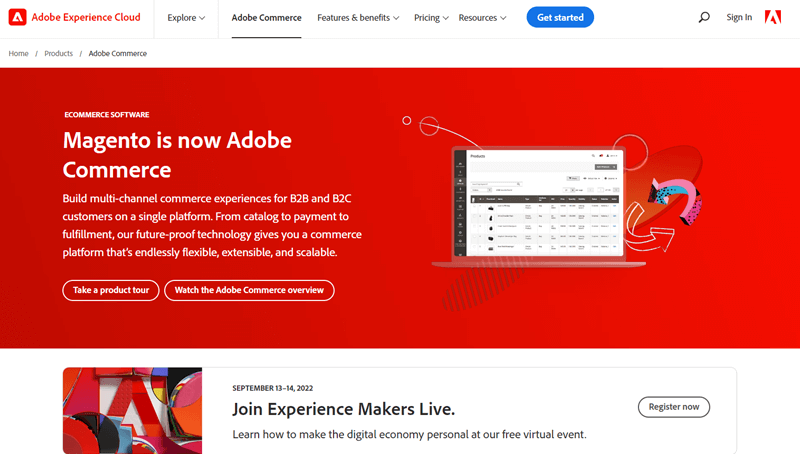
So, it’s obvious that CMSs come with eCommerce features to sell any kind of product you want. For that, you can find multiple eCommerce add-ons, built-in features, or integration to eCommerce tools on them.
While LMS is also a kind of CMS platform designed especially for eLearning sites. And it also comes with good eCommerce functionality to sell your courses.
Some eCommerce functions you’ll get on LMS platforms are:
- Connection with payment gateways like Stripe, PayPal, etc. to accept payments.
- Coupon codes to offer discounts.
- Ability to sell single and bundled courses, etc.
For instance, LearnDash comes with multiple selling options. That includes one-time purchases, subscriptions, shopping carts, memberships, course bundles, bulk access, etc.
2. Reporting and Analytics
Both LMS and CMS platforms have reporting or analytics functions to monitor the performance of sites.
In CMSs, you may find built-in analytics or integration to tools like Google Analytics. This lets you gather and analyze data about your sites. And the insights can be about the device users are using, how users are interacting with the content, popular content on your site, etc.
For instance, Ghost includes an engagement analytics function to understand what content gets the most attention. Also, it lets you know who your top viewers are.
While in the case of online course sites, reporting is also vital to monitor course progress, track training, analyze exam results, etc. For that, LMS platforms come with built-in reporting tools. With that, you can reward your learners and improve the performance of your courses.
Take the example of TalentLMS. It provides extensive reporting about everything occurring in your LMS. Also, you’ll see a timeline of all the system actions and a report builder to get insights.
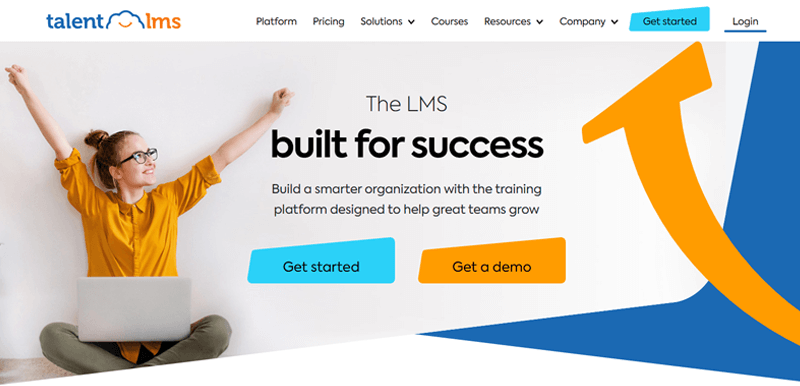
3. Security Features
Security is very important for any site to protect your and your users’ data. Thus, every CMS and LMS includes its own set of security features. Now, let’s know some of them.
When it comes to LMS, some security features are:
- Frequent data backups.
- System audit logs to monitor the activities in the platform.
- Locked content that prevents users from downloading course materials.
- Secure and complex password requirements.
- User roles and permissions, etc.

In LifterLMS, there are security features to keep your learning materials safe. For that, users who are supposed to view them can only access them.
CMSs include most of the security features of LMS platforms. Plus, features like Content Delivery Network (CDN) to prevent DDoS (Distributed Denial of Service) attacks, etc.
For example, Drupal has security features like user access control, database encryption, prevention against malicious data entry, and more.
4. Multilingual Content/Courses
Most CMS and LMS platforms let you make your content in multiple languages to expand the customer’s reach globally. Moreover, it also increases accessibility and content optimization.
In LMS software, you can translate course material into other languages. So that students can learn your courses simply. For instance, LearnPress translates into languages like English, Chinese, etc.
Similarly, for CMS platforms like WordPress, there are many multilingual plugins. Using them, your site will automatically translate into different languages.
5. Good Support
Lastly, LMS and CMS platforms offer support to their users through various means. It can be from a phone call, email, ticket system, guides, etc. And for that, they may have a support team.
TalentLMS has a help center that lets you go through its guides, video tutorials, etc. Also, you can contact the team by phone call, or by ticketing system to get support.
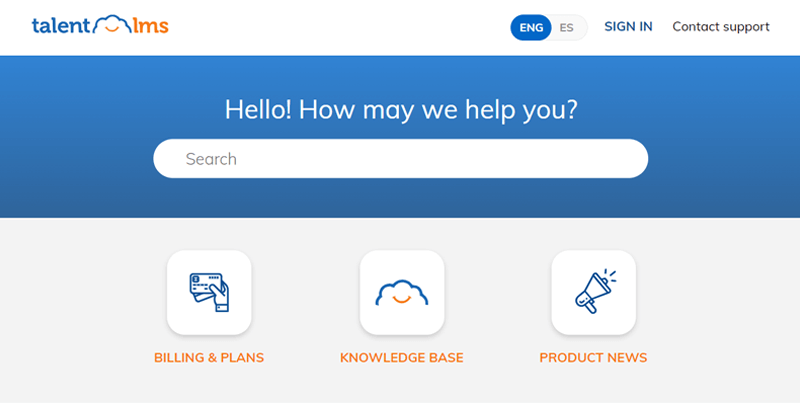
While for the CMS platform, Joomla has 700K+ community members in the support forum. Also, it contains other methods like documentation.
With that, this concludes the differences and similarities between LMS vs CMS platforms. For a quick recap, check the comparison table on LMS vs CMS next.
F. Comparison Table Between LMS vs CMS
| Platform/Features | LMS | CMS |
| Type of Website | Online course or membership sites | Any |
| Main Users | Trainers, Companies, Institutes, etc. | Content developers |
| Login Access | Yes | Yes |
| Content Access Level | Yes | Yes |
| Tracking Users | Possible by individuals and groups | Only by the content author |
| Collaboration | Both employees and learners | Employees only |
| Content Automation | Yes | No |
| Sharing User Data | Yes | No |
| Schedule Events | Yes | Only when using plugins for events |
| Workflow Tools | No | Yes |
G. Pros and Cons of LMS Platforms
Now, let’s check the pros and cons of LMS platforms.
| Pros of LMS Platforms | Cons of LMS Platforms |
| Reduces learning costs and makes learning easy. | Adds the administrative costs. |
| Lets you build interactive and personalized courses. | Requires at least some programming or IT knowledge. |
| Highly customizable and easy to update. | Multiple features may overwhelm you. |
| Able to track the training records to measure the progress of learners. | Complicated content management system. |
| Gives unlimited access to the learning materials. | Need to be aware of maintaining security. |
| Stores and provides access to all courses from one place. | May lack pre-built assessments to easily get started. |
H. Pros and Cons of CMS Platforms
Here, let’s see the pros and cons of CMS platforms now.
| Pros of CMS Platforms | Cons of CMS Platforms |
| Reduces overall cost and time for creating sites. | Need to focus on maintaining the security of sites. |
| Offers lots of plugins, themes, and add-ons. | Using a premium theme and many plugins may be costly. |
| Gives a simple and easy-to-use interface. | A slight learning curve at the beginning. |
| Mostly comes with built-in SEO features. | Comes with multiple real-time updates that you should be aware of. |
| Lets you collaborate with multiple users. | You must be careful while configuring the platform based on your site needs. |
I. Final Verdict on LMS vs CMS – Which You Need?
Both LMS and CMS systems let you create and manage content. LMS platforms are specially designed for learners to view, listen, and interact with your course materials and assessments. For that, it contains several learning tools and methods for an engaging experience.
On the opposite side, CMS platforms include a wide range of features for the delivery of any type of content. This also includes making general course sites. But it’s a general storage and organization system that doesn’t prioritize the course instructor or student.
This means students and learners can just see a simple view of documents from a site built using a CMS platform. However, some CMS platforms like WordPress let you add LMS functions to your website. That’s by integrating it with an LMS platform using an LMS plugin like LearnDash.
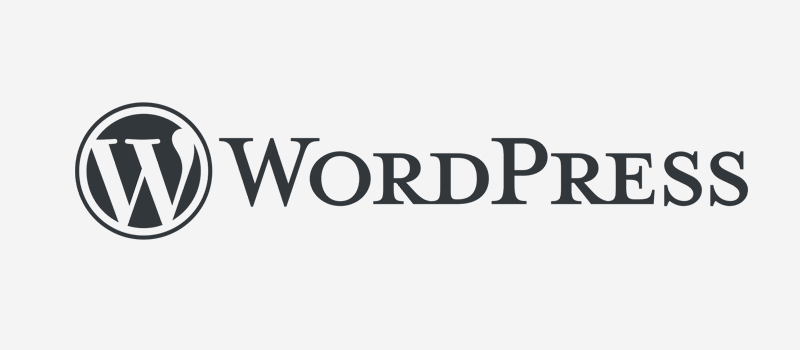
Therefore, if you want to create a website other than an eLearning site, then you can go with a CMS platform. But for an online course site, you must use an LMS platform.
Although, we also recommend you use simpler CMS platforms like WordPress with integration to LMS functionalities. At last, the choice is all yours! This concludes our LMS vs CMS comparison.
Conclusion
Now, let’s wrap! We’re already at the end of this LMS vs CMS article.
Going through this blog, you may have understood the features, examples, pros, and cons of LMS and CMS. So, we hope you were able to determine which platform you need for your site.
To sum up, you can choose an LMS platform to receive all the features of an eLearning site. While managing your content with powerful tools, a CMS platform is what you need for any kind of site.
If you’re stuck at any place, then comment below. We’re eagerly waiting to help you out.
Right now, you can go through some helpful blogs on LifterLMS vs LearnDash and LearnDash alternatives.
Lastly, follow us on Facebook and Twitter to stay connected with us.

